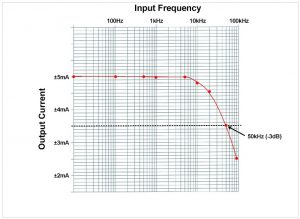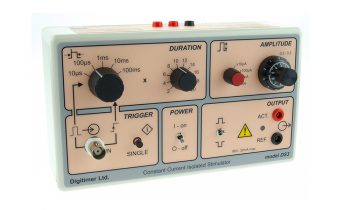Description
DESCRIPTION
The DS4 Bi-Phasic Current Stimulator has been developed to meet the needs of life scientists who require a stimulus isolator that can output a bi-phasic isolated constant current stimulus in response to an external command voltage signal, provided by a computer DAC via software. Such a requirement is already met by our NeuroLog System in the form of the NL512 Biphasic Buffer and NL800A Stimulus Isolators, but the DS4 Bi Phasic Stimulator provides our first standalone device to meet this need. The DS4 is intended for use in animal or in vitro electrophysiological applications where low noise is an absolute requirement. The DS4 is not intended for safe human use.
Low Noise Isolated Output Stage
The DS4 features a DC supply to power the control circuitry while the stimulation voltage arises from two banks of batteries in the low noise, optically isolated output stage. The DS4 is not a traditional triggered stimulator, but is instead driven by a biphasic voltage waveform that it converts into a proportional constant current stimulus. This means that the DS4 can produce monophasic or biphasic stimuli which can vary in shape from rectangular pulses to sine waves or even totally arbitrary waveforms. The DS4 features two input sockets – the main INPUT socket is where the voltage command signal is applied and the optional GATE input may be used to turn stimulation on and off using TTL logic, rather like a “soft on/off switch”.
Stimulate with arbitrary shaped waveforms
As the DS4 operates like a voltage to current amplifier, the stimulator has specfic frequency response characteristics, which determine how well it can follow rapidly changing or high frequency command signals. The frequency response plot for the DS4 is shown below, illustrating the performance when a ±5V input is applied with the DS4 set to a maximum input range of ±10V, an output range of ±10mA and a load of 1kohm. The graph shows that the -3dB roll-off is at 50kHz, while the expected DS4 output is constant for frequencies up to 5kHz.

Unique “Inactivity Sensor” Prevents Unwanted DC Stimulation
One of the problems with stimulators that make use of an external voltage source to define a stimulus waveform is that small offsets or noisy baseline signals from the DAC’s used to drive them can result in unwanted battery drain or perhaps worse, low amplitude stimulation. The DS4 uses a special “inactivity sensor” to monitor the input voltage and disable the DS4 output if this voltage falls below 0.15% of the full scale value (in -ve or +ve directions) for a user selectable timeout of 200ms, 500ms, 1s or 2s. Unlike other devices which only ever produce an output when the input voltage exceeds a threshold value, this “inactivity sensor” reduces battery usage and damaging “leak currents” during infrequent stimulation, while at the same time maintaining low levels of zero crossing distortion for repetitive waveforms.
The inactivity sensor timeout can be adjusted between the four possible settings using on board jumpers which are accessible from the battery compartment. It is important to note that the inactivity sensor will result in a slight “glitch” in the stimulus waveform when the DS4 is first used after a period of inactivation. This is because the inactivity sensor prevents any output until the command input voltage exceeds ±0.15% of the full scale.
The DS4 Stimulator uses an external DC power supply to power the input control circuitry and readily available/inexpensive batteries to provide the opto-isolated stimulus voltage source. The DS4 can be fitted into a 19″ rack mounting frame (D121-11) which can hold up to two DS2A’s, DS3’s DS4’s or DG2A’s.
GALLERY
DOWNLOADS
DS4 Bi-Phasic Stimulus Isolator
Datasheet
DS4 Bi-Phasic Stimulus Isolator
Operator’s Manual
DS4 Application Note
Animal/In Vitro Nerve Excitability with QtracW
References
Publications which cite use of the Digitimer D185 can be found on Google Scholar.
ACCESSORIES
Supplied
- Power Supply Adaptor
- Mains Lead
- Operator’s Manual
- One set of batteries
- Pair of output plugs (NL985P)
Recommended
- DS4-BATT – Set of Replacement Batteries
- Additional NL985P Output Plugs
FAQS
The DS4 operates like a voltage to isolated current amplifier and as such, its behaviour with high frequencies signals can be described in terms of a frequency response. When a ±5V input is applied to a DS4 set to a maximum input range of ±10V, an output range of ±10mA and connected to a load of 1kohm, the -3dB roll-off point is at 50kHz, while the expected DS4 output is constant for frequencies as high as 5kHz.
Yes, the DS4 has featured in a number of studies of evoked neurotransmitter release. Due to it’s ability to be driven by a biphasic voltage waveform, the DS4 can be set up to deliver brief burst of biphasic electrical stimulation via bipolar electrodes, which are precisely timed to occur between the FSCV scans.
The DS5 and DS4 have similar control methods, in that each is driven by a biphasic voltage waveform. For animal use there is no requirement for a medical device and the output current ranges of the DS4 are also more suitable, so we would indeed recommend the DS4 for threshold tracking applications in animals (in vitro or in vivo).










